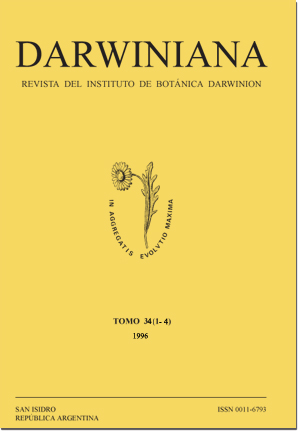Synopsis of Caesalpinia and Hoffmannseggia (Leguminosae- Caesalpinioideae) of South America.
DOI:
https://doi.org/10.14522/darwiniana.2014.341-4.423Abstract
Caesalpinia L. sensu lato, is a pantropical genus with approximately 150 species: 40 of them occur in South America. There is great morphological variation within Caesalpinia: it includes trees, shrubs, and perennial herbs, some scandent, armed or not; hair-covering is di verse; pedicels are jointed or not; flowers with imbricated and falling sepals: legume chartaceous to woody, unarmed or echinate, frequently with dendromorphus hairs. Its species inhahits forests and semi-deserts. Two subgenera are currently accepted in this genus: Caesolpinia. with species in the New and Old World, characterized by not winged fruits and subgenus Mezoneuron (Desf.) Vidal ex Herendeen & Zarucchi. a subgenus of Old World species with winged fruits. Caesalpinia still needs further detailed studies in order to clarify its generic delimitation at a worldwide level. Hoffmannseggia Cav. sensu stricto, includes nearly 20 species growing from southern United States, N of Mexico, Andean and semi-deserts zones of Peru, Bolivia to Chile and Argentina; 13 of these species occur in South America. This genus is probably a derived evolutionary unit from primitive Caesalpinia like group and it is mainly defined by herbaceous plants, sub-stemless and with gemmiferous roots, pedicels not jointed, flowers with sepals generally valvate, persistent, and legume without dendromorphus hairs.Downloads
Published
31-12-2011
How to Cite
Ulibarri, E. A. (2011). Synopsis of Caesalpinia and Hoffmannseggia (Leguminosae- Caesalpinioideae) of South America. Darwiniana, Nueva Serie, 34(1-4), 299–348. https://doi.org/10.14522/darwiniana.2014.341-4.423
Issue
Section
Systematics and Taxonomy of Plants
License

Starting on 2012, Darwiniana Nueva Serie uses Licencia Creative Commons Atribución-NoComercial 2.5 Argentina .






